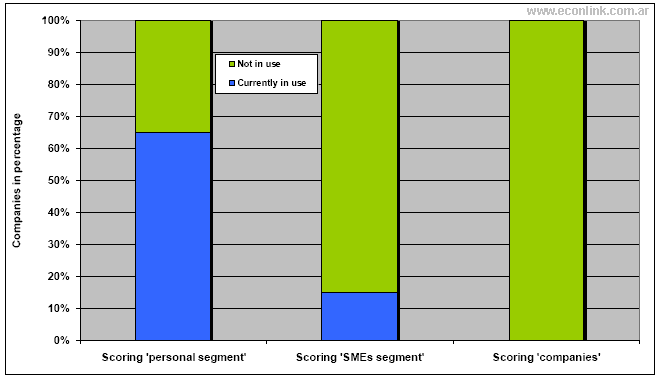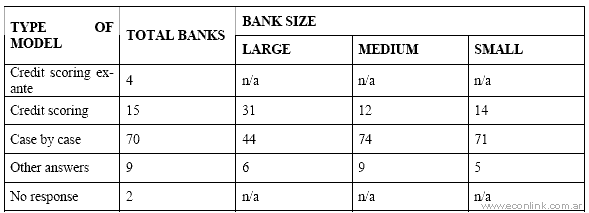The information available regarding the measurement systems used in this period by the Argentinean financial system is scarce, imprecise and not very reliable, thus we’ll base our analysis in a work performed by the BCRA on October 2006 (Pailhé, 2006). We’ve to recognize that the macroeconomic situation suffered significant changes ten years after the period that occupy our work, but in terms of internal development of the banking system the techniques and procedures applied to each customer are quite similar, thus the analysis in this section has to be taken with some precautions.
The measurement technique was and is based on two basic tools which are the ‘scoring’ and ‘rating’ ones. The ‘scoring’ tool is more used to evaluate individuals and SMEs; the ‘rating’ tool is applied to larger companies.
Scoring system
The scoring is a tool that allows classifying the applicants of credits and debtors based on its risk, assigning them to groups or giving a determined amount of points (score).
In that process the system uses statistical techniques or artificial intelligence, assigning to each group or score a risk level (probability of default). These systems are used in the origination of credits, comparing the minimum value (cut-off) associated to the risk that the bank would accept and the return expected. This is known as Lending Scoring System.
They are also used in the monitoring of the clients, to manage credit limits, to identify profitable accounts, to offer new products, to monitoring risk and to anticipate collection problems. This is known as ‘Monitoring Scoring System’
Rating
Whereas the scores are used mainly for individuals and SMEs, the ratings are used to evaluate larger companies. This method reflects the credit quality of the borrower without taking into consideration the type of product that the customer has taken form the entity.
The rating must represent the evaluation of the bank on the capacity and will of the borrower to fulfil the contract despite of unfavourable economic conditions or the occurrence of unexpected events.
These systems in general have more degrees of risk classification than the norms of the BCRA. In such sense, these organizations declared to have scales up to 26 degrees or levels of risk.
These two systems were the most used by the financial institutions, obviously not taking into consideration the ‘soft information’ produced by commercial departments and agents in general. But what is more interesting for our analysis is the coverage that these techniques had in relation with the SME sector. We’re going to be focused in the ‘Scoring’ method as was the one applied to evaluate the SME sector. Again there’s no information available on the period covered by this work, but we can accept a high grade of similarity with the results obtained on 2006.
As a considerable percentage of ‘personal loans’ are in fact ‘SME loans’ we’re going to consider both in the data obtained. The same showed that 85% of the entities used some kind of scoring system to ‘personal segment’. In between them only 30% declared that the ‘score’ result was decisive in the lending decision, the rest of the entities used this technique along with another kind of decision tools.
Only 15% of the entities declared to have in operation scoring systems for SMEs, representing around 19% of the commercial credits (see Figure 10).
Figure 10. UTILIZATION OF ‘LENDING SCORING SYSTEM’ BY TYPE
OFPORTFOLIO. ARGENTINA 2006.

Source: Translated from Pailhé C. (2006).
The ‘scoring systems’ were developed internally in half of the banks considered in the study, the rest were using systems developed by third parties or even outsourcing the task. In general in the development of the systems statistical techniques are used prevailing the logistic regression. The risk of default measure increases as the score decreases.
At this point we’ve to clear an important point: due to the lack of valuable collaterals a large percentage of SMEs borrow money as ‘personal loans’, this is not in the name of the company but in the name of the owner of it.
Monitoring scoring system
Regarding ‘personal segment’ half of the financial institutions counted on a monitoring scoring system basically to increase the limits of financings granted, thus half of the entities didn’t used a ‘hard information’ generation system for this purpose.
Half of the systems were internally developed.
On the ‘SME segment’ only 5% of the organizations declared to have in application a monitoring scoring system for overdraft current accounts, that due to the type of product is considered applicable for SMEs.
Notes on the scoring system.
Another important circumstance was that most of the entities coincided on the information regarding customer identification, risk evaluation and legal-economic information, but regarding the ‘collaterals’ the information dispersion was absolute. This point can give us an idea of the ‘asymmetric information’ existed between banks and borrowers at the time of evaluate collateral requirements.
In general terms we’ll consider an intermediate situation in between the ‘personal segment’ and ‘SMEs segment’ at the moment to analyze the ‘hard information’ generation in the banks on the period 1994/00.
However, it was observed that it would’ve worked as a ‘first filter’, in which based on score further actions are taken, which they can be the rejection of the request (low scores), manual revision (scores intervals) or fulfilment of other requirements, like for example the relation income/quote (high scores).
Following the results obtained by some studies (Sarghini, 2001; Pailhé, 2006) we can conclude that the information generated in order to evaluate the SME financing demands was based mainly on ‘soft information techniques’. The ‘hard information’ generation was relatively more used in larger companies through methods like ‘rating’ or ‘scoring system’, but even so the financial system doesn’t seems to have been a ‘hard info’ based one.
Closing this section we’re going to make a mention to the Latin American market situation and to an experience evaluated in the United States.
The characteristics of the ‘credit risk’ measurement systems were similar in all the Latham countries over the same period with different grades. On average the ‘credit scoring’ was used by 14% of the smaller banks to evaluate SMEs loans and 71% of them used the ‘case by case’ method, that obviously represents higher evaluation costs. Curiously the situation wasn’t very different for the rest of banks by size, thus 12% of medium sized banks used the ‘credit scoring’ and 74% the ‘case by case’ one (see Table 6). So we can conclude that the high information costs were present in most Latham financial systems of the period.
Table 6. UTILIZATION OF SCORING SYSTEMS BY SIZE OF BANK.
LATINAMERICA 2004. ON PERCENTAGES.

Source: Translated from FELABAN (2005).
Finally we’re going to make reference to the work performed by the Federal Reserve of the United States (Berger, 2007): they evaluated the performance of a new ‘risk measurement’ system called SBCS (Small Business Credit Scoring) on the period 1993/97. In between 14.000 individual newly issued loans to small business they found that banks using this technology reduced the information gaps, lessened their need for collateral and furthermore reduced the borrower and lender costs improving the efficiency of the small business lending market.
Como citar este texto:
Anonimo (01 de Sep de 2008). "Measurement systems". [en linea]
Dirección URL: https://www.econlink.com.ar/information-banking/measurement-systems (Consultado el 14 de Mayo de 2021)